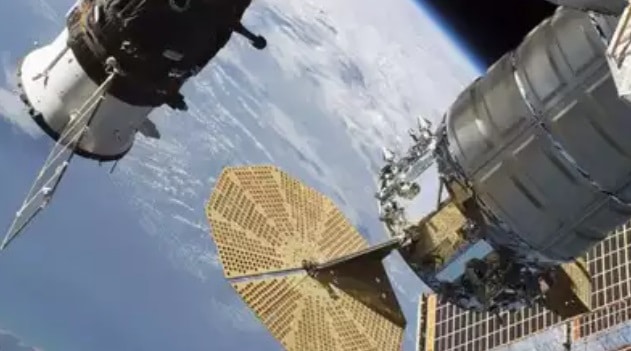What’s in today’s article?
- Why in news?
- International Space Station (ISS)
- What is International Space Station (ISS)?
- What are the features of ISS?
- Why Is the Space Station Important?
- News Summary: 25 years of the International Space Station
- When did the International Space Station launch?
- What scientific discoveries on the ISS have benefited life on Earth?
- How long will the ISS be operational?
Why in news?
- The International Space Station (ISS) turned 25 years old on November 20, 2023. The first module of the ISS launched into orbit in 1998.
What is International Space Station (ISS)?
- ISS is a large spacecraft in low Earth orbit.
- It is habitable spacecraft that orbits Earth at an average altitude of approximately 420 kilometers (260 miles).
- It serves as a unique and collaborative space laboratory, research facility, and living space for astronauts and cosmonauts from various countries.
What are the features of ISS?
- Construction and Ownership
- The major partners include NASA (United States), Roscosmos (Russia), ESA (European Space Agency), JAXA (Japan Aerospace Exploration Agency), and CSA (Canadian Space Agency).
- In 2022, Russia announced that it will pull out of ISS after 2024 and focus on building its own orbiting outpost.
- These agencies have contributed modules, components, and resources to construct and maintain the station.
- The major partners include NASA (United States), Roscosmos (Russia), ESA (European Space Agency), JAXA (Japan Aerospace Exploration Agency), and CSA (Canadian Space Agency).
- Size and Structure
- The ISS is quite large, with a mass of around 460 tons and a habitable volume roughly equivalent to the interior of a Boeing 747 aircraft.
- It consists of various interconnected modules and components, including laboratories, living quarters, and docking ports.
- Orbit and Duration
- It travels at 8 kilometers (5 miles) per second. This means it orbits Earth every 90 minutes.
- It passes over our heads 16 times every 24 hours — travelling through 16 sunrises and sunsets.
- Missions typically last six months, although some crew members may stay for shorter or longer durations.
- It travels at 8 kilometers (5 miles) per second. This means it orbits Earth every 90 minutes.
- International Crew
- The ISS is continuously inhabited by a rotating crew of astronauts and cosmonauts from different nations.
- These crew members live and work on the station for several months at a time, conducting experiments, maintaining systems, and performing various tasks necessary to keep the station operational.
Why Is the Space Station Important?
- One of the primary purposes of the ISS is to conduct scientific research and experiments in the unique microgravity environment of space.
- Microgravity is often referred to as near zero gravity or weightlessness.
- Researchers from around the world use the station to study a wide range of fields, including biology, physics, astronomy, and Earth sciences.
- The ISS has contributed to our understanding of topics such as human health in space, materials science, and climate change.
- Human beings have been living in space every day since the first crew arrived.
News Summary: 25 years of the International Space Station
When did the International Space Station launch?
- The first segment of the ISS — the Zarya Control Module — was Russian and launched November 20, 1998.
- Zarya supplied fuel storage and battery power, and served as a docking zone for other space vehicles arriving at the ISS.
- Later, in December 1998, the US launched the Unity Node 1 module. Together, the two modules were the start of a functioning space laboratory.
- Over the course of 42 assembly flights, the ISS became what it is today.
What scientific discoveries on the ISS have benefited life on Earth?
- Astronauts have conducted hundreds of scientific experiments on the ISS.
- From Alzheimer’s and Parkinson’s disease to cancer, asthma and heart disease — it’s all been studied in space.
- Scientists say some medical experiments are best done in space because cells behave in microgravity more like they do inside the human body, but it’s difficult to recreate such conditions on Earth.
- There have been discoveries to benefit drug development, new water purification systems, methods to mitigate muscle and bone atrophy and those that have led innovations in food production.
How long will the ISS be operational?
- Plans for the future operation of the ISS were thrown into uncertainty with the start of Russia’s invasion of Ukraine in early 2022.
- Both the European Space Agency and national bodies withdrew from international collaborations with Russia.
- Later, Russia said it was leaving the ISS to build its own space station.
- Also, old and new space faring nations want to make an independent mark on space. They include Japan, China, India, the United Arab Emirates and others.
- The US and Europe have said they remain committed to the International Space Station through 2030.
- But plans are afoot for a post-ISS world, as well:
- NASA is almost entirely focused on its Artemis program and plans to populate the moon.
- ESA is working toward a new space station, which it is calling Starlab.
Q1) What is near zero gravity or weightlessness?
Weightlessness, also known as zero gravity, is the complete or near-complete absence of the sensation of weight. It’s a state in which the apparent gravity effect is zero.
Q2) What is JAXA?
The Japan Aerospace Exploration Agency (JAXA) is a Japanese government agency that conducts research and development in the fields of aviation and space exploration. JAXA is responsible for all civilian space activities in Japan.
Source: 25 years of the International Space Station: Why it was launched, what it does | NASA | Britannica | Times of India
Last updated on June, 2025
→ UPSC Notification 2025 was released on 22nd January 2025.
→ UPSC Prelims Result 2025 is out now for the CSE held on 25 May 2025.
→ UPSC Prelims Question Paper 2025 and Unofficial Prelims Answer Key 2025 are available now.
→ UPSC Calendar 2026 is released on 15th May, 2025.
→ The UPSC Vacancy 2025 were released 1129, out of which 979 were for UPSC CSE and remaining 150 are for UPSC IFoS.
→ UPSC Mains 2025 will be conducted on 22nd August 2025.
→ UPSC Prelims 2026 will be conducted on 24th May, 2026 & UPSC Mains 2026 will be conducted on 21st August 2026.
→ The UPSC Selection Process is of 3 stages-Prelims, Mains and Interview.
→ UPSC Result 2024 is released with latest UPSC Marksheet 2024. Check Now!
→ UPSC Toppers List 2024 is released now. Shakti Dubey is UPSC AIR 1 2024 Topper.
→ Also check Best IAS Coaching in Delhi






















